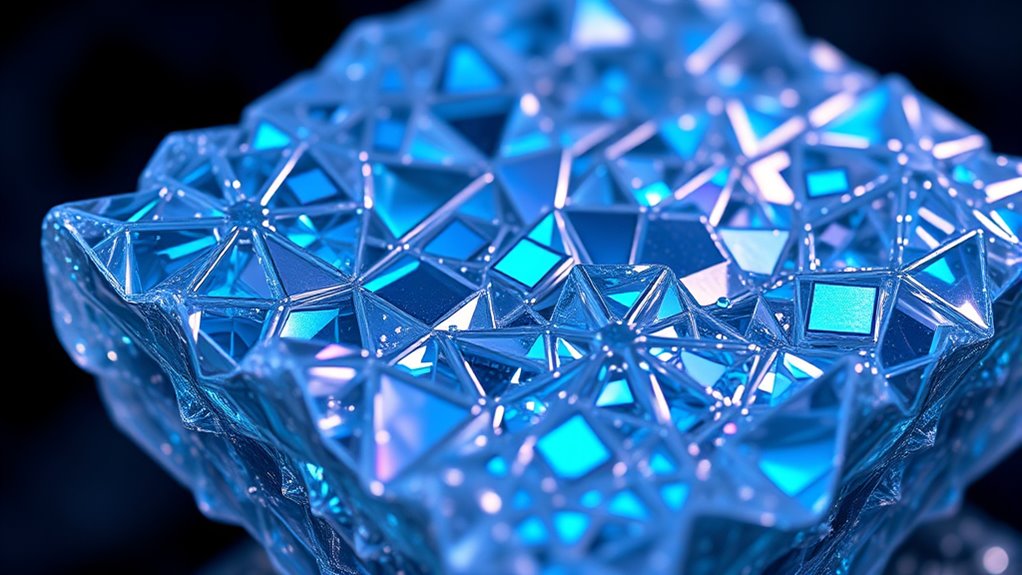Time crystals are a new form of matter that defy traditional physics by sustaining perpetual motion without energy loss. Unlike typical crystals, which form in space, time crystals exhibit rhythmic motion over time, breaking the usual symmetry. You might find them created in quantum laboratories, showing stability despite their ongoing oscillations. This breakthrough challenges your understanding of energy and stability, and if you’re curious, you’ll discover more about how they could revolutionize science.
Key Takeaways
- Time crystals are quantum systems that exhibit perpetual, rhythmic motion without energy loss, breaking time-translation symmetry.
- Unlike traditional crystals, they show repeating patterns over time rather than in space.
- They exist in nonequilibrium states, maintaining oscillations without increasing entropy or violating thermodynamics.
- Created in controlled environments like quantum computers, they challenge conventional physics principles.
- Their discovery opens new avenues in quantum physics and potential applications in quantum computing technology.

Have you ever wondered if matter could defy the usual rules of energy and motion? Well, time crystals challenge that very idea. They are quantum systems where particles engage in repetitive motion, maintaining a stable state of perpetual movement without losing energy. Unlike anything you’ve encountered before, these structures don’t follow the conventional rules that energy dissipates over time. Instead, they exhibit motion without traditional kinetic energy, which seems to go against expectations but actually conserves energy overall. This unique behavior results from their ability to break time-translation symmetry by repeating patterns over time, making them both stable and ever-changing simultaneously. Think of them as systems that keep oscillating, not because they’re powered by an external force, but because their quantum properties cause them to sustain this rhythm intrinsically.
Unlike space crystals, which are defined by how atoms arrange themselves in space, time crystals are characterized by their temporal pattern—how particles move over time. They exist in a nonequilibrium state, meaning they aren’t in thermal equilibrium like most matter. This is *vital* because it allows them to sustain perpetual motion without energy loss, a feat that defies how we usually understand thermodynamics. In fact, experiments have demonstrated that these systems can maintain their motion without violating the second law of thermodynamics. Their entropy remains stationary, indicating no increase in disorder, even as they continue to oscillate. This means they conserve energy and don’t generate or dissipate heat, unlike typical systems that slow down or settle into equilibrium. The development of many-body localization has been critical in enabling these systems to avoid thermalization and maintain their ordered oscillations over time. Additionally, research into quantum coherence is essential for understanding how time crystals preserve their delicate quantum states during oscillation.
Scientists have successfully created time crystals in controlled environments, such as Google’s quantum computer, where laser-driven dynamics help establish rhythmic motion. These experiments require precise conditions to prevent energy from leaking out, making their creation and maintenance technically challenging. Researchers have also explored different materials, including diamond-based time crystals, highlighting their versatility. Despite their perpetual motion, time crystals can’t be used as a perpetual energy source or work device since no energy is gained or lost—they simply exist in a steady, oscillating state.
Fundamentally, time crystals break a core symmetry in physics called time-translation symmetry. Usually, stable systems look the same over time, but in this case, the system spontaneously shifts into a state where its properties change periodically. This breaking of symmetry is a key feature that sets them apart and makes them a groundbreaking discovery in quantum physics. They represent a new phase of matter, one that challenges our understanding of energy, stability, and motion, opening doors to potentially revolutionary applications in quantum computing and beyond.
Frequently Asked Questions
Can Time Crystals Be Used for Practical Energy Storage?
You’re wondering if time crystals can be used for practical energy storage. While the concept is still in development, they show promise because their ability to maintain periodic states could lead to more efficient energy retention. If scientists succeed in creating and controlling them, time crystals could revolutionize energy storage systems, especially for renewable sources. However, practical applications are still largely theoretical and need further research and experimental validation.
Are Time Crystals Stable Over Long Periods?
You might think time crystals aren’t stable long-term, but recent evidence shows they can maintain their oscillations indefinitely under certain conditions. Noise actually helps their stability, and experiments with Rydberg gases prove this. While challenges remain, especially with larger systems, the potential for stable, long-lasting time crystals is promising. This suggests that, with further research, they could become reliable components in advanced technologies like quantum computing and sensing.
How Do Time Crystals Interact With Conventional Matter?
You might wonder how time crystals interact with conventional matter. They do so through quantum effects like quasiparticle exchange, not classical forces. When in contact, they maintain their coherence, allowing quantum information to transfer without energy loss. However, environmental noise can disrupt this interaction, so the stability depends on controlling external disturbances. Larger time crystals tend to be more stable, enabling better integration with ordinary matter in quantum systems.
Could Time Crystals Enable Faster-Than-Light Communication?
You might wonder if time crystals can enable faster-than-light communication. Currently, physics says no; their oscillations are internal and don’t carry usable information faster than light. While they’re fascinating, time crystals don’t break the fundamental rules of relativity or causality. You won’t find evidence that they can transmit messages instantaneously. Instead, scientists explore their potential for quantum computing, not for surpassing the speed of light in communication.
What Are the Ethical Implications of Manipulating Time Crystals?
Think about the ripple effect of your actions—manipulating time crystals isn’t just a scientific feat, it’s a moral puzzle. You must weigh safety risks, environmental impacts, and societal fairness. With such power, ethical oversight becomes essential to prevent misuse or unintended consequences. You hold responsibility for transparency, regulation, and ensuring these groundbreaking technologies serve humanity positively, not harm or divide it. The ethical stakes are as high as the potential breakthroughs.
Conclusion
Don’t worry if time crystals sound like science fiction; they’re real and fascinating! Some might think they break the laws of physics, but they actually reveal new, exciting possibilities in understanding matter. By studying these strange structures, you get a glimpse into a future where our understanding of time and energy could change dramatically. So, stay curious—what seems impossible today could be tomorrow’s groundbreaking discovery!










